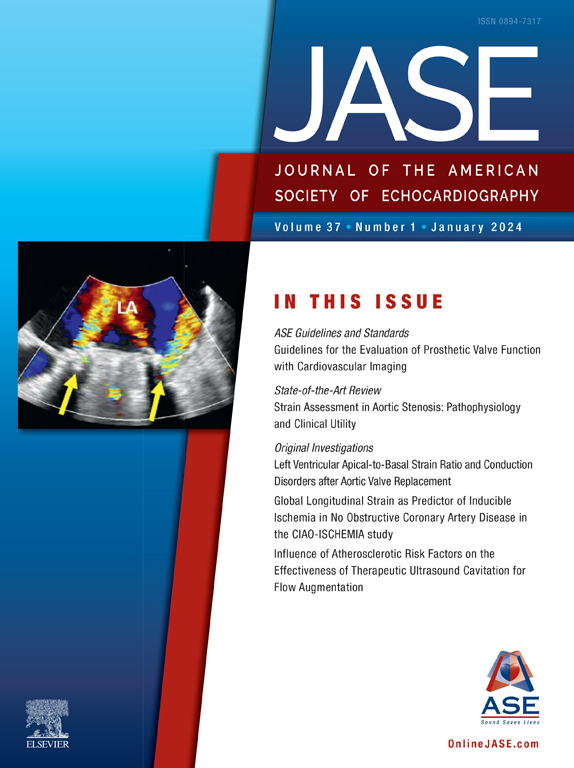Mechanical Adaptation of the Right Ventricle to Secondary Tricuspid Regurgitation and Its Association With Patient Outcomes
IF 5.4
2区 医学
Q1 CARDIAC & CARDIOVASCULAR SYSTEMS
Journal of the American Society of Echocardiography
Pub Date : 2025-07-01
DOI:10.1016/j.echo.2025.02.011
引用次数: 0
Abstract
Background
Data regarding right ventricular (RV) mechanical adaptation to secondary tricuspid regurgitation (STR) are scarce.
Objectives
The aim of this study was to investigate changes in RV contraction pattern in patients with different degrees of STR severity and etiologies and their association with outcomes.
Methods
A total of 205 patients with STR (60% women; mean age, 77 ± 12 years) were enrolled in a single-center prospective observational study. Three-dimensional echocardiography was used to measure RV ejection fraction (RVEF); the absolute contributions of the longitudinal component of RVEF (LEF), the radial component of RVEF (REF), and the anteroposterior component of RVEF (AEF); and their relative contributions by indexing to global RVEF (LEF/RVEF, REF/RVEF, and AEF/RVEF, respectively). Patients were followed for a median of 9 months. The primary outcome was heart failure hospitalization or all-cause death.
Results
Patients with different degrees of STR severity did not differ in terms of RVEF (mild vs moderate vs severe: 50 ± 11% vs 49 ± 9% vs 50 ± 10%, respectively, P = .085). However, LEF/RVEF was significantly lower in patients with severe STR (0.39 ± 0.08 vs 0.39 ± 0.09 vs 0.35 ± 0.10, respectively, P = .049). Patients with ventricular STR had lower global RVEF (48 ± 10% vs 53 ± 8%, P = .001), LEF (18 ± 6% vs 20 ± 5%, P = .043), REF (23 ± 9% vs 28 ± 8%, P = .002), and REF/RVEF (0.48 ± 0.012 vs 0.52 ± 0.09, P = .040) than patients with atrial STR. In a multivariable Cox regression model, REF/RVEF was a significant and independent predictor of outcomes in the entire cohort (hazard ratio, 0.980 [95% CI, 0.961-1.000] per 0.01-unit change, P = .047), whereas global RVEF was not.
Conclusions
Patients with STR demonstrate significant functional RV remodeling. Patients with severe STR show a significant decrease in RV longitudinal shortening. Apart from STR severity, STR etiology also influences the RV contraction pattern, which was associated with outcomes in our cohort.
右心室对继发性三尖瓣反流的机械适应性及其与患者预后的关系。
背景:关于右心室(RV)对继发性三尖瓣反流(STR)的机械适应性的数据很少。目的:我们研究不同STR严重程度和病因患者右心室收缩模式的变化及其与预后的关系。方法:在一项单中心前瞻性观察研究中,我们招募了205例STR患者(60%为女性,年龄:77±12岁)。我们使用三维超声心动图测量右心室射血分数(RVEF),右心室纵向(LEF)、径向(REF)和正位(AEF)射血分数分量的绝对贡献,以及它们的相对贡献,通过索引全局RVEF (LEF/RVEF;REF / RVEF;时/ RVEF)。患者随访时间中位数为9个月。主要结局定义为心力衰竭住院或全因死亡。结果:不同STR严重程度患者的RVEF没有差异(轻度vs中度vs重度,RVEF分别为50±11% vs 49±9 vs 50±10%,p=0.085)。然而,严重STR患者的LEF/RVEF显著降低(分别为0.39±0.08 vs. 0.39±0.09 vs. 0.35±0.10,p=0.049)。心室STR患者整体RVEF(48±10%比53±8%,p=0.001)、LEF(18±6%比20±5%,p=0.043)、REF(23±9%比28±8%,p=0.002)和REF/RVEF(0.48±0.012比0.52±0.09;在多变量Cox回归模型中,REF/RVEF是整个队列结果的显著独立预测因子(风险比为0.980 [CI, 0.961-1.000] / 0.01单位变化,p=0.047),而整体RVEF则不是。结论:STR患者表现出明显的功能性右心室重构。严重STR患者右心室纵向缩短明显减少。除了STR严重程度外,STR病因也影响右心室收缩模式,这与我们队列的结果相关。
本文章由计算机程序翻译,如有差异,请以英文原文为准。
求助全文
约1分钟内获得全文
求助全文
来源期刊
CiteScore
9.50
自引率
12.30%
发文量
257
审稿时长
66 days
期刊介绍:
The Journal of the American Society of Echocardiography(JASE) brings physicians and sonographers peer-reviewed original investigations and state-of-the-art review articles that cover conventional clinical applications of cardiovascular ultrasound, as well as newer techniques with emerging clinical applications. These include three-dimensional echocardiography, strain and strain rate methods for evaluating cardiac mechanics and interventional applications.

 求助内容:
求助内容: 应助结果提醒方式:
应助结果提醒方式:


